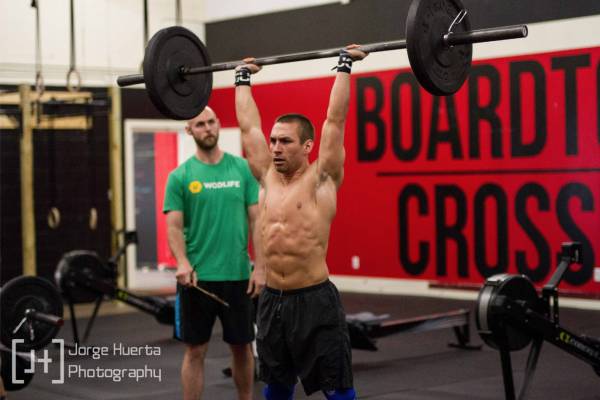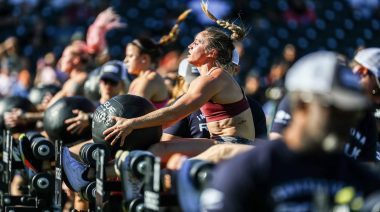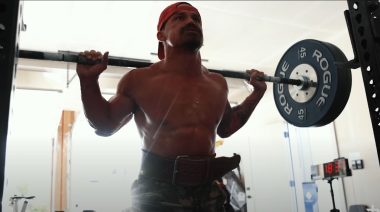There is a strange paradox that develops in CrossFit athletes, from high-level performers to weekend warriors. Their training – or overtraining – crushes their bodies, but they are still able to perform at an amazing level.
Actually, this isn’t such a crazy paradox as we see it in a lot of populations faced with fight-or-flight situations. The body can push through in order to survive, but typically these scenarios are not sustained like they are with CrossFit Games-bound athletes.
But while these athletes can turn the engine on and get the job done, they are setting the stage for a system-wide breakdown. In the case of many high-level CrossFitters, there is poor focus on absolute recovery and this leads to serious health complications as their training career progresses.
The Breakdown of the System
In 2013 my coach, Brad Davidson, and I had the opportunity to work with the top three female winners of the CrossFit Games regarding their nutrition and supplementation. Since then, we have worked with several more top athletes, typically referred to us once they have become broken.
After a long period of under-recovery, an athlete will hear about how we correct major physiological damage, call us, work with us, recover, and then typically place high in their choice of competition. Brad is even considered a secret-weapon for a lot of CrossFitters.
“Pushing high intensity exercise with poor recovery isn’t really doable – or even recommended.”
Pushing high intensity exercise with poor recovery isn’t really doable – or even recommended. Instead, we first stress the importance of recovery with our athletes. Training is only as good as the recovery. If you are under-recovered, your training doesn’t cause beneficial progression. It causes the body to enter survival mode.
We have noticed this inability to recover not only in high-level CrossFit competitors but also in the average athlete. So much energy is spent on the WOD that the time in the remainder of the day just isn’t there for recovery. Or worse yet, an athlete may just not know how to recover. Nutrition is weak, supplements are whatever the gym sells, and mobility means watching a five-minute video with a sweet-talking guy in San Fran but the athlete doesn’t actually do what he says.
Case Study on Poor Recovery
When Brad got the initial phone call from Kim (name changed), she shared a whole list of negative symptomology. Zero energy, no sex drive, no desire to train, hair loss, inability to breathe properly, always feeling cold, loss of hearing, inability to get out of bed for hours after the alarm went off, and even memory loss. Despite Kim being on a super clean diet, she felt worse energetically and was gaining body fat somewhat consistently.
“Quality sleep, nutrition tailored to your training and goals, and supplementation are of utmost importance.”
Keep in mind, Kim is a long-time and awesome CrossFit competitor. If things were this out of order for one of the best, imagine the crushing circumstances of under-recovery for those below this athlete’s level. All of the above reported symptoms were in full effect one month prior to the CrossFit Open when Kim came to us, so our time was limited.
Kim had incorrectly assumed her negative symptoms were a normal part of training because they had happened before, but never to this degree. But when the symptoms became worse she knew something had to change. As Brad put it to me:
“As the Open and Regionals and Games get closer, most of the fittest are so under-recovered that their knowledge becomes limited on how to fix the situation. So they do the wrong things and don’t seek help. Most in fact just try to train harder and it doesn’t work.”
As Brad further explained, “The system isn’t broken, the athlete is broken. It really isn’t the CrossFit programming. It’s the inability to recover from the demands of the programming.”

The Four Phases of Recovery
To get started on our four-phase recovery plan, we asked Kim to order blood work, as well as complete other testing (adrenal, immune system, digestive, and cognitive function). All results showed signs of severe wear and tear. Athletes are often mentally in fight mode, but physically in flight mode. Their cortisol is out of whack, and this becomes a major problem.
Brad explained to Kim it wasn’t her fault. There was a lack of strategy regarding the most important aspect of training – recovery. This recovery should involve nutrition and supplementation going into a workout and coming out of it. If an athlete turns on the “fight,” then they need to shut it down and bring on the recovery methods to heal from the battle.
“If things were this out of order for one of the best, imagine the crushing circumstances of under-recovery for those below this athlete’s level.”
This ability to control and enhance recovery can improve the capability of the individual to fight. Without this, the athlete’s brain may feel fully invested in killing the workout, but the body only wants to flee. Why? Because the body thinks it is constantly fighting and it wants to survive.
Essentially Kim was expressing major signs of adrenal and thyroid down regulation, sluggish liver, and high levels of inflammation. What does this do or mean physically?
- Sluggish Liver: This affects work capacity and brain function, and can cause extreme lethargy. If someone is a “slow morning starter,” it is usually because the liver is burdened.
- Adrenal Issues: This affects strength, energy, and work-load capacity. It causes catabolism, sex hormones to drop, and the immune system to not function well at all (Kim was getting sick almost every month), as well as unneeded joint pain. Another symptom is very harsh mood swings.
Instead of making progress through training, training was making Kim worse. This makes recovery very hard, if not impossible, and does not allow any athlete to benefit from the training stimulus.
The Protocol for Kim
The plan Brad created was simple. In the time before the workout, Kim needed to prepare her body for the workout itself. Afterward, the remainder of the day would be focused on healing and recovering. Relax and conquer, then relax a lot.
Note: This is an example of what was given to Kim, and is not intended for actual use.
Upon Waking:
- Half of a lemon squeezed in warm water to aid liver support and wake the body
- Glass of essential and non-essentials amino acids
- Sea salt for aiding adrenals and waking the body
In regard to nutrition, everything was kept simple and revolved around the proper use of protein and fats, especially leading into training to help improve brain function and create a good, natural form of energy.
- Olympic lifting session: coffee, green tea, L-tyrosine, GPC (all to drive overall brain function).
- Metcon: Green tea (not as much caffeine as coffee, and it supports the liver), plus fish oil or a product we used called InxAglity EKG (to enhance blood flow), plus beta alanine (to buffer lactic acid). This combination wakes the body up and aids the liver, all without accelerating heart rate too high.
Don’t Forget the Carbs
One thing Brad and I have seen a lot is that CrossFit athletes go into competition carb depleted. Most CrossFitters under-eat carbs. This causes under-recovery and depleted glycogen levels. We have found if we add carbs into athletes’ diets whose metabolisms are sluggish (from too much training volume) they are able to increase their recovery.
“Most CrossFitters under-eat carbs. This causes under-recovery and depleted glycogen levels.”
In some cases, we have even programmed athletes to increase carb intake by to as much as 600-700g a day. For these athletes, even as the carbs went up, their body fat percentage went down and their performance kept peaking. We have yet to see a high-performing CrossFit athlete gain body fat by adding carbs to their diet. So, for Kim, every meal after a workout included complex carbs.
Dirty Sleep
Brad also developed a sleep hygiene focus for Kim. Sleep hygiene entails the ability to fall asleep within twenty minutes of lying down, stay asleep, and wake up naturally without hitting snooze. If you aren’t able to do those three things, to one degree or another, you have bad sleep hygiene – or “dirty sleep.” During sleep the body repairs itself. Without it, it doesn’t. It is that simple.
Using liver support and new sleep strategies designed by Brad to enhance deeper and more recovery-inducing sleep, Kim’s negative symptomology decreased, and her energy and performance increased.

The End Result for Kim
Due to not just being an awesome athlete, but also dedicating herself to a recovery protocol, Kim was able to finish high enough in the SoCal Regionals to secure a spot for the CrossFit Games.
Brad and I encounter countless CrossFitters who are under-recovered due to missing out on these key aspects. But you don’t have to be a high-level CrossFitter for this to apply to you. Anyone who is training hard needs to recover harder. If you are following a training program, there should be an associated recovery program. If you don’t have one, then find one.
“The above recovery methodologies are just the basics. There are a lot more specifics, but if you are not doing the basics, the specifics won’t matter.”
The above recovery methodologies are just the basics. There are a lot more specifics, but if you are not doing the basics, the specifics won’t matter. Quality sleep, nutrition tailored to your training and goals, and supplementation are of utmost importance. Training, especially training hard, should come after that.
Your training won’t push you to the next level or a healthy state of being without these elements in line. Recovery is an art, and like any art, it should involve dedication, presence, and mastery.
Read more on recovery:
- How Your Recovery Relates Directly to Your Performance
- Eating To Recover: How and What to Eat Post Workout
- 7 Essential Elements of Rest and Recovery
- What’s New On Pulse Beat Fit Today
Photo 1 & 3 courtesy of Shutterstock.
Photo 2 courtesy of Jorge Huerta Photography.






